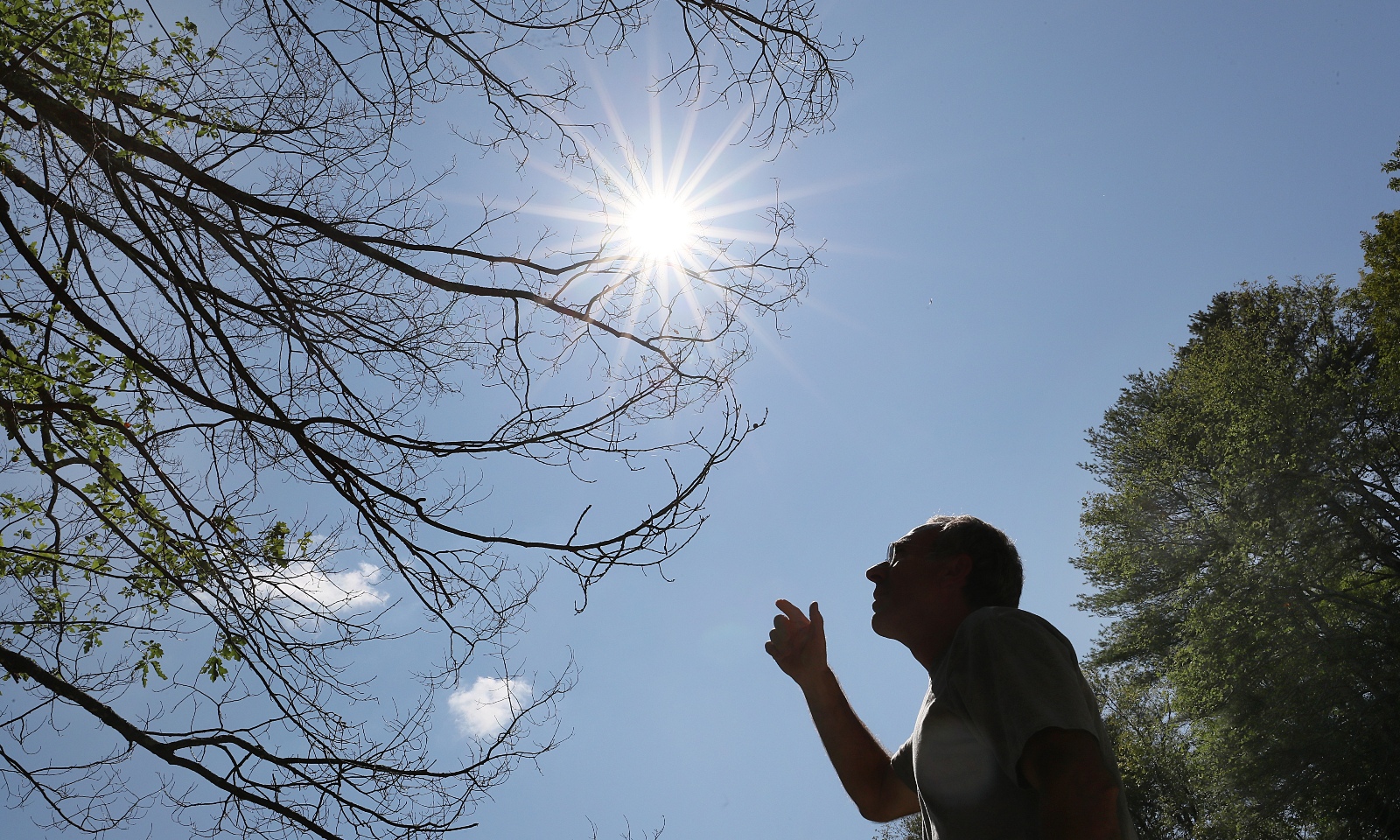Take a few steps into a leafy forest in New York’s Hudson Valley, close your eyes, and listen: That’s not the sound of rain, it’s millions of caterpillars chewing and pooping.
On a clear spring day, the pitter-patter of spongy moth caterpillars eating their way through oak, maple, crab apple, basswood, and aspen trees can be heard over the sound of birds singing. Bits of green leaves litter the ground like confetti — evidence of the insatiable chewing taking place in the canopy above. Hundreds of caterpillars bob on long, wispy silk threads, waiting for a breeze to carry them to a new tree.
The Northeast and Midwest are enduring what is, in some places, the worst outbreak of spongy moths on record. One of the factors driving the proliferation of very hungry caterpillars is climate change-spurred drought, which allows spongy moths to breed with abandon, producing up to a million caterpillars per acre. Trees are resilient, but this outbreak has been especially long and damaging. After two consecutive years of intensive spongy moth feeding, up to 80 percent of trees in a hardwood forest that has been defoliated, or stripped of its leaves, will die. The current spongy moth epidemic has lasted five years in some parts of the U.S.
“When trees are defoliated like this right at this time of year, they are using reserves that are in the trunk and in the roots to put out a second flush of growth,” said Brian Eshenaur, a plant pathologist at Cornell University’s Integrated Pest Management Program. “If the tree has to do that two years in a row, it’s really tapping all the reserves it has.”
The caterpillars aren’t the only forest pests benefiting from climate change. Many invasive species in the U.S. are expanding, generally thanks to milder winters brought on by warmer-than-average global temperatures. Insects like the hemlock woolly adelgid, the emerald ash borer, the Japanese beetle, and the spotted lanternfly are chewing their way through the country’s trees at record paces — leading to widespread tree mortality and stressed forests that are susceptible to drought and more disease. No one species is capable of taking down the nation’s forests, which collectively store some 60 billion metric tons of carbon, but the rising tide of invasive species is doing serious cumulative damage.
Spongy moths have been in the United States since 1869, when a French artist and amateur entomologist named Etienne Leopold Trouvelot imported some from Europe and began raising them in netting in his backyard near Boston. Trouvelot was hoping to breed a silkworm suited to American climes that could be used for commercial textile production. Spongy moths, known as gypsy moths at the time, float from leaf to leaf and tree to tree on long, durable lines of silky thread. But the moths soon escaped from captivity, perhaps because a heavy storm tore through Trouvelot’s netting, and some of the bugs decamped to the Massachusetts woods.

Two decades later, in the midst of the first spongy moth infestation on record, one resident of the town in which Trouvelot lived described a world carpeted with black, hairy caterpillars. “I do not exaggerate when I say that there was not a place on the outside of the house where you could put your hand without touching caterpillars,” the resident told the Boston Post in 1889. (The caterpillars don’t bite humans, but coming into contact with their spiky hairs causes some people to develop an itchy and painful rash.)
For more than a century after that initial outbreak, spongy moths spread at a rate of about 13 miles per year through New England, the Mid-Atlantic, the Midwest, and parts of the South, feasting on 300 species of leafy trees and shrubs and leaving entire stretches of forest bare in their wake. The moths defoliated 81 million acres cumulatively between 1970 and 2013. Because of the toll they take on trees, keeping spongy moth populations in check has become one of the U.S. Forest Service’s highest priorities. The economic cost of managing spongy moths has averaged $30 million per year for the past 20 years.
And climate change is making things worse. Outbreaks typically occur every eight to 12 years, and each surge lasts one to three years. The current outbreak has lasted longer than usual, said Tom Coleman, a Forest Service entomologist who manages the agency’s Slow the Spread spongy moth program, in part because of drought in some of the areas that the moths inhabit.
Drought affects the spread of a fungal pathogen called Entomophaga maimaiga that curbs spongy moth populations. The fungal pathogen, originally found in Japan, was introduced by researchers to the U.S. as a spongy moth control measure in the early 1900s. The pathogen can be incredibly effective at killing the moths in their caterpillar stage, but it needs a cool, wet spring in order to proliferate. Cyclical outbreaks of spongy moths often follow years that are drier than average, when the pathogen is not as prevalent in the environment. “Without that fungal pathogen keeping the populations in control, we get these large outbreaks,” Coleman said.
In the eastern portions of the country where spongy moth outbreaks occur, climate change is making weather patterns more erratic. Much of the eastern U.S. is projected to become wetter, on average, as the planet warms. But climate change also fuels pockets of drought in these regions during warm months. Drought in 2023 and the beginning of 2024 in northern Virginia, southern Pennsylvania, and parts of Wisconsin and Michigan helped fuel this year’s outbreak. Drought at the huge scale often seen in the American West isn’t a prerequisite for spongy moth outbreaks in the east. “It doesn’t have to be a whole annual drought,” Coleman said. “It can just be a rather warmer, dry spring.”
It’s unclear whether rising temperatures will cause spongy moths to emerge more frequently, but it is safe to assume that a warmer, drier environment will cause cyclical outbreaks to become more intense over time. Luckily, the Forest Service has had some luck deploying more than 100,000 pheromone-laced traps to catch the bugs as they try to push west. The agency has also treated 10 million acres of forest with a biological insecticide that kills the caterpillars, preventing the bugs from establishing in new places.
Still, experts worry about the multipronged threats America’s trees face from pests and climate change, and the intersection of those two dangers. “Not only can climate change affect insects, it can also make trees that are native to a certain area less suited,” Eshenaur said. “A lot of our trees in the Northeast can’t tolerate high temperatures and sustained drought. That can make them more susceptible to these new pests that are coming in.”
Correction: A photo caption in this story originally misidentified a different type of moth as a spongy moth.




